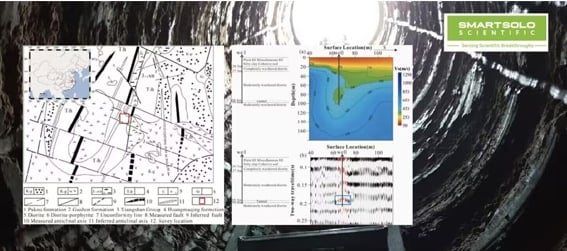Project Overview
Seismic imaging using ambient noise has become a highly effective method for mapping underground structures. By analyzing ambient noise recorded by seismic arrays, the spatial autocorrelation (SPAC) method enables imaging of subsurface velocity structures across varying scales.
This study leverages advanced seismic imaging techniques to detect abandoned mine tunnels, which are characterized by low-velocity anomalies. The combined application of the SPAC and autocorrelation methods provides high-resolution imaging along the linear array of tunnels.
Equipment Used
- 136 SmartSolo Node Seismometers: Deployed across three linear survey lines with station spacings of 1.5 meters and 5 meters for detailed data collection.
Study Objectives
The primary objectives of this study are:
- Detecting Abandoned Mine Tunnels: Identifying low-velocity anomalies indicative of abandoned subsurface structures.
- Enhancing Seismic Imaging Techniques: Evaluating the effectiveness of the SPAC and autocorrelation methods in high-resolution underground mapping.
- Understanding Subsurface Velocity Structures: Providing detailed velocity models of the subsurface using environmental noise.
Key Methodology
- SPAC Method: Utilized to analyze spatial correlations of ambient noise data and generate subsurface velocity profiles.
- Autocorrelation Method: Applied to enhance the resolution of seismic imaging in complex underground environments.
- Seismometer Deployment: 136 SmartSolo short-period seismometers were strategically positioned along three linear arrays with specific spacings to optimize data accuracy.
Deployment Configuration
- Linear Array Survey Lines: Three arrays were established, with station spacings of 1.5 meters and 5 meters respectively.
- Continuous Recording: Data were recorded continuously to capture detailed ambient noise signatures for precise imaging.
Significance of the Study
This research demonstrates the effectiveness of using dense seismic arrays and environmental noise for underground exploration. Key contributions include:
- Identifying abandoned tunnels with high accuracy, which is critical for safety and environmental monitoring.
- Enhancing our understanding of subsurface velocity anomalies using non-invasive techniques.
- Showcasing the capability of SmartSolo seismometers in demanding field conditions.
Conclusion
By combining the SPAC and autocorrelation methods with SmartSolo seismic technology, this study sets a benchmark for imaging mine tunnels and similar underground structures. The innovative approach provides critical insights into subsurface features, paving the way for safer and more efficient exploration techniques.

